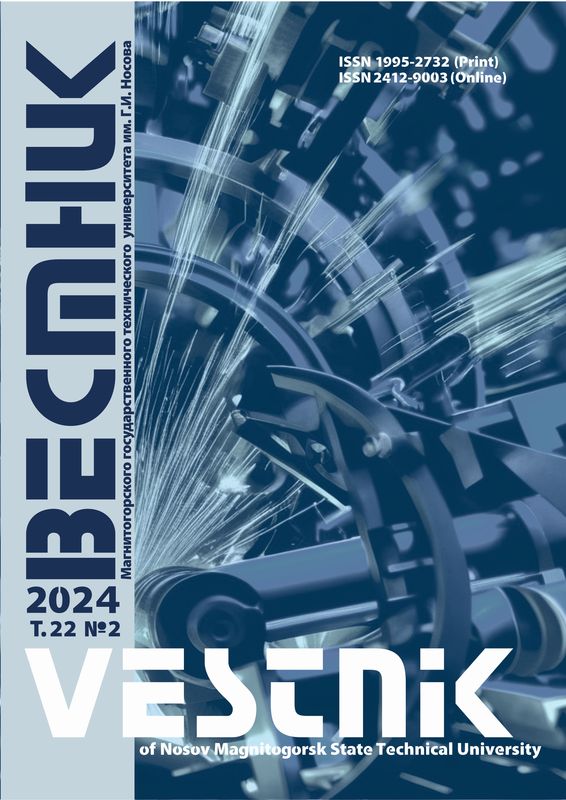DOI: 10.18503/1995-2732-2024-22-2-79-87
Abstract
Problem Statement (Relevance). The Ural region, as a Russian center of metallurgy, over several centuries of work has accumulated a huge number of slag dumps, which are now practically unexplored, although they can be useful for the national economy. Unfortunately, slag disposal currently occurs spontaneously and does not take into account the possibility of potential recycling. Many types of slags, containing valuable and rare elements, represent potential ore. Objectives. The study is aimed at investigating a mineral (material) composition of slags from the Verkhnesysertsky Iron Works located in the south of the Sverdlovsk Region (the Middle Urals). Methods Applied. The chemical composition of slag was determined with an XRF 1800 X-ray fluorescence wave spectrometer by Shimadzu, and a composition of minerals was determined with a CAMECA SX 100 electron probe microanalyzer with five wave spectrometers. Photographs of minerals and their relationships with one another were taken using a JSM-6390LV scanning electron microscope by Jeol. Originality. The material composition of slags was studied and analyzed using the modern nomenclature of the International Mineralogical Association and the application of classic mineralogy. Findings. The authors are the first to study mineralogy of ferruginous slags from the Verkhnesysertsky Iron Works. It has been established that these slags are composed of an aggregate of fayalite and laihunite and contain abundant dissemination of magnetite. In addition, they contain chromite, merrihueite and non-crystallized glass. These slags are waste from puddling iron production, and temperature of their formation is 1200-1400°C. Laihunite may be a typomorphic mineral of the slags of the puddling process, because the technological mixing of the melt leads to its saturation with oxygen and oxidation. Practical Relevance. The slag under study can be further processed. When using a magnetic separation, it is easy to get magnetite, which is an ore for iron with valuable impurities of chromium, vanadium and nickel. The slag in the shape of blocks can be used as a refractory material.
Keywords
fayalite, laihunite, magnetite, mineralogy, puddling slags, Verkhnesysertsky Iron Works
For citation
Erokhin Yu.V., Ponomarev V.S., Zakharov A.V. A Material Composition of Puddling Slags (Using the Example of the Verkhnesysertsky Plant, the Middle Urals). Vestnik Magnitogorskogo Gosudarstvennogo Tekhnicheskogo Universiteta im. G.I. Nosova [Vestnik of Nosov Magnitogorsk State Technical University]. 2024, vol. 22, no. 2, pp. 79-87. https://doi.org/10.18503/1995-2732-2024-22-2-79-87
1. Alekseev V.V. Metallurgicheskie zavody Urala XVII – XX vv. Entsiklopediya [Metallurgical plants of the Urals in the 17th – 20th centuries. Encyclopedia]. Yekaterinburg: Academic Book Publishing House, 2001, 536 p. (In Russ.)
2. Savichev A.A. Arkhitekturnoe dostoyanie Syserti. Chast 1. Istoricheskiy tsentr [Architectural heritage of Sysert. Part 1. Historical center]. Yekaterinburg: Ural Worker Publishing House, 2018, 200 p. (In Russ.)
3. Karabasov Yu.S., Chernousov P.I., Korotchenko N.A., Golubev O.V. Metallurgiya i vremya. Entsiklopediya. V 4 t. T. 2. Fundament industrialnoy tsivilizatsii. Vozrozhdenie i Novoe vremya. [Metallurgy and time. Encyclopedia. In 4 volumes. Vol. 2. Foundation of the industrial civilization. The Renaissance and Modern Period]. Moscow: Moscow Institute of Steel and Alloys, 2011, 216 p. (In Russ.)
4. Frisch T., Herd R.K. Highly metamorphosed iron-formation on Arcedeckne Island, Boothia Peninsula, Arctic Canada, and the paragenesis of harrisonite, Ca(Fe,Mg)6(SiO4)2(PO4)2. Canad. Miner. 2010;48(4): 1005-1024. DOI:10.3749/canmin.48.4.1005
5. Kozlov P.S., Erokhin Yu.V. New data on fayalite slag from of the Mariinsky Processing Plant. Mineralogiya tekhnogeneza [Technogenesis Mineralogy]. 2013;(14): 67-76. (In Russ.)
6. Khisina N.R., Khramov D.A., Kleschev A.A., Langer K. Laihunitization as a mechanism of olivine oxidation. European Journal of Mineralogy. 1998;10:229-238.
7. Martin A.M., Medard M., Devovard B., Keller L.P., Righter K., Devidal J.-L., Rahman Z. Fayalite oxidation processes in Obsidian Cliffs rhyolite flow, Oregon. American Mineralogist. 2015;100:1153-1164. DOI:10.2138/am-2014-5042
8. Chesnokov B.V., Shcherbakova E.P. Mineralogiya gorelykh otvalov Chelyabinskogo ugolnogo basseyna (opyt mineralogii tekhnogeneza) [Mineralogy of burnt dumps of the Chelyabinsk coal basin (the experience of technogenesis mineralogy)]. Moscow: Science, 1991, 152 p. (In Russ.)
9. Tzankova N., Stavrakeva D. Mineralogical study of archaeological cooper slags found in the area of Krushevets Village, SE Bulgaria. Geologica Balcanica. 2020;49(2):3-23.
10. Portillo-Blanco H., Zuluaga M.C., Ortega L.A., Alonso-Olazabal A., Cepeda-Ocampo J.J., Salcedo A.M. Mineralogical characterization of slags from the Oiola Site (Biscay, Spain) to assess the development in bloomery iron smelting technology from the Roman Period to the Middle Ages. Minerals. 2020;10:321. DOI: 10.3390/ min10040321
11. Beregovsky V.I., Kistyakovsky B.B. Metallurgiya medi i nikelya [Metallurgy of copper and nickel]. Moscow: Metallurgy Publishing House, 1971, 456 p. (In Russ.)
12. Piatak N.M., Seal II R.R. Mineralogy and environmental geochemistry of historical iron slag, Hopewell Furnace National Historic Site, Pennsylvania, USA. Applied Geochemistry. 2012;27(3):623-643. DOI: 10.1016/ j.apgeochem.2011.12.011
13. Erokhin Yu.V., Ponomarev V.S., Zakharov A.V., Leonova L.V. Mineralogy of copper slags of the Sysert iron-working plant, the Middle Urals. Mineralogiya [Mineralogy]. 2023;9(2):30-40. (In Russ.) DOI: 10.35597/ 2313-545X-2023-9-2-3
14. Vakhrusheva N.V., Shiryaev P.B., Stepanov A.E., Bogdanova A.R. Petrologiya i khromitonosnost ultraosnovnogo massiva Rai-Iz (Polyarnyi Ural) [Petrology and chromite content of the Rai-Iz ultramafic massif (the Polar Urals)]. Yekaterinburg: Institute of Geology and Geochemistry, the Ural Branch of the Russian Academy of Sciences, 2017, 265 p. (In Russ.)
15. Erokhin Yu.V. Mineralogy of slags from the Rezhevsky Nickel Plant. Mineralogiya tekhnogeneza [Technogenesis Mineralogy]. 2012;(13):50-64. (In Russ.)
16. Bas M.J.L., Maitre R.W.L., Streckeisen A., Zanettin B. A chemical classification of volcanic rocks based on the Total-Alkali-Silica diagram. Journal of Petrology. 1986;27(3):745-750. DOI: 10.1093/petrology/ 27.3.745
17. Dodd R.T., Van Schmus W.R., Marvin U.B. Merrihueite, a new alkali-ferromagnesian silicate from the Mezö-Madaras chondrite. Science. 1965;149:972-974. DOI:10.1126/science.149.3687.972
18. Postl W., Taucher J., Moser B. Neue Mineralfunde im oststeirischen Vulkangebiet. Mitteilungen der Abteilung Mineralogie am Landesmuseum Joanneum. 1996;60-61:3-76.












